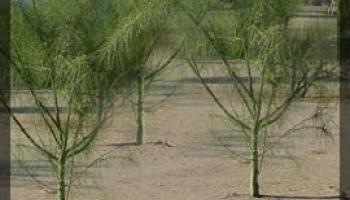Archival Notice
This is an archive page that is no longer being updated. It may contain outdated information and links may no longer function as originally intended.
Home | Glossary | Resources | Help | Contact Us | Course Map
In addition to the forensic application of DNA typing of humans and animals, scientific technology has allowed the forensic community to type plants as well. Unlike nuclear DNA analysis in humans, plant DNA is not unique because plants can be cloned. But if a plant is cloned, it can be typed or matched to its source
Plant DNA was first used in the United States in a murder case in the 1990's. Arizona investigators found the nude body of a woman lying face down in a bush beneath a Palo Verde tree. A witness observed a truck leaving the area. The suspect identified in this case denied having been in the area where the woman's body was found; however, criminal investigators located two Palo Verde seedpods in the bed of this pickup truck. DNA testing showed the seedpods had originated from the same Palo Verde grove where the murdered woman's body was recovered. In State v. Bogan, 905 P.2d 515; 183 Ariz. 506; 188 Ariz. Adv. Rep. 31 (Ariz. Ct. App. 1995), the defendant was convicted after a jury trial, and the conviction was upheld on appeal. Bogan identified two classic forensic uses of DNA: directly connecting the suspect to a crime scene and directly refuting the suspect's statement to police regarding not being present.
Additional Online Courses
- What Every First Responding Officer Should Know About DNA Evidence
- Collecting DNA Evidence at Property Crime Scenes
- DNA – A Prosecutor’s Practice Notebook
- Crime Scene and DNA Basics
- Laboratory Safety Programs
- DNA Amplification
- Population Genetics and Statistics
- Non-STR DNA Markers: SNPs, Y-STRs, LCN and mtDNA
- Firearms Examiner Training
- Forensic DNA Education for Law Enforcement Decisionmakers
- What Every Investigator and Evidence Technician Should Know About DNA Evidence
- Principles of Forensic DNA for Officers of the Court
- Law 101: Legal Guide for the Forensic Expert
- Laboratory Orientation and Testing of Body Fluids and Tissues
- DNA Extraction and Quantitation
- STR Data Analysis and Interpretation
- Communication Skills, Report Writing, and Courtroom Testimony
- Español for Law Enforcement
- Amplified DNA Product Separation for Forensic Analysts



